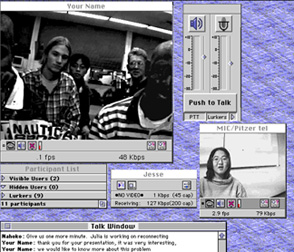Constructing Courses Following the Content-Based Approach to Internet Literacy
| Internet Learning Module |
|---|
| Viewing Word to Web, a
"Director" movie, requires the Shockwave Plug-in.* (© Dana Ward) |
Mastering each computing application always involves learning content material. In addition to completing content-based tasks during the course, there is often a "cap stone" project which requires students to combine several computing and internet applications.
|
|
| INTERNET PENPALS |
|---|
| English language learners can be introduced to the internet and personal writing through email penpals from around the world. An excellent resource for teachers looking for penpals is through the Intercultural Email Classroom Connections. |
| URL |
| http://www.stolaf.edu/network/iecc/ |
| MODERATED LIST FOR ESL STUDENTS |
|---|
| English language learners at the college level can be introduced to moderated discussion lists by joining a student list. In addition to two general discussion lists, CHAT-SL (low level) and DISCUSS-SL (high level) students can choose to subscribe to topical lists. There are currently lists dedicated to learning English, current events, movies, music, and sports. |
| URL |
| http://www.stolaf.edu/network/iecc/related-lists/ANNOUNCE-SL |
| SYLLABUS |
|---|
| Comparative Political Issues |
| URL |
| http://www.miyazaki-mic.ac.jp/classes/compoliss/compoliss.html |
| INTERNET TREASURE HUNT |
|---|
|
Below is a list of questions that can
be answered by "surfing" the
internet. You have until the end of
the Political Science class to email me
your answers. Be sure to use the
search engines found on "Web
Connections". Prizes will be awarded to the first four people to answer all the questions, or to the four people who have answered the most questions at the end of the hour. You must properly cite your source. |
| 1. What was the rate of growth in Gross Domestic Product (GDP) for Egypt in fiscal year 1992/93? |
| 2. If you are in Hong Kong, and want to go by subway from Diamond Hill to Kowloon Bay, what line do you take and how long will it probably take? |
| 3. In what year did La Trobe University in Australia open? |
| 4. What is the Italian word for government? |
| 5. How many Yuan is a U.S. dollar worth in China? |
| 6. Who wrote "Alchemy for a New World Order -- Overselling Preventive Diplomacy" in the May/June 1995 issue of Foreign Affairs? |
| 7. What does the first paragraph of the "Final Act Embodying The Results of the Uruguay Round of Multilateral Trade Negotiations (GATT treaty) say? |
| 8. Who is the current President of Costa Rica? |
| 9. What is the Japanese word for profligate? |
| 10. What is the exact text of the first amendment to the U.S. Constitution? |
| SAMPLES |
|---|
| Art History Student Papers |
| URL |
| http://www.miyazaki-mic.ac.jp/~jkaret/ahtask.html |
The easiest way to introduce students to HTML is to have them link their
| HTML Project |
|---|
| THE DIGITAL CONSUMER |
| Student Projects and Project Guidelines |
Each student produced a Consumer's Guide to Online Shopping for a particular product or service, consisting of several web pages of their own text, linked to WWW shopping sources all over the world. The projects were "published" when students linked their final product to their own homepages.
 class at Pitzer College
in California. Students from both sides of the world
shared their knowledge about environmental problems and solutions, providing the
Japanese students with a unique opportunity to communicate "face-to-face", in
English, with their American counterparts.
class at Pitzer College
in California. Students from both sides of the world
shared their knowledge about environmental problems and solutions, providing the
Japanese students with a unique opportunity to communicate "face-to-face", in
English, with their American counterparts.
| FTP EXERCISE |
|---|
| An English language activity using TPR (Total Physical Response) was developed to teach both vocabulary and show students how FTPing works. Computers in the classroom were labeled as "clients" and "servers". Students were given roles and signs identifying them as "Fetch" (a MAC application for transferring files, download a copy), and as "Compact Pro" (the file compression application). By acting out the sequence necessary for FTPing, students mastered both the language and the application. |